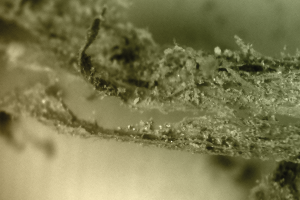According to experts, the antique pocket watch carried by the captain of the Hunley did not wind down gradually after the world’s first successful combat submarine was lost at sea in 1864; nor did it have its hands moved by some outside force. Instead the watch stopped at 8:23. Scientists say it is likely water or a strong concussion caused his watch to stop working, offering a vital clue in their efforts to uncover what happened in the final moments before the Hunley and her crew vanished.
When archaeologists found the watch in Dixon’s vest pocket during excavation of the submarine, they were hopeful it would help answer a lingering mystery: how long did the crew survive after the Hunley’s historic sinking of the USS Housatonic? If the submarine had suffered a violent blow or had rapidly taken on water, the time displayed on the watch would likely be frozen near the moment those events occurred. However, when the watch was carefully opened in 2004, experts were surprised to find the time set at approximately 8:23. What scientists could not immediately answer was whether the time recorded was AM or PM.
It is an important distinction. If the time was PM, that would mean the watch stopped before many eyewitnesses say the Hunley struck the Housatonic with its torpedo and caused it to sink. Accounts from survivors of the wreck vary, but a majority of the witnesses place the attack from anywhere between 8:45 to 9:00 PM. The other possible scenario was that the time reflected the day after the attack, and the watch had simply wound down.
“The Hunley is full of secrets, but she never gives them up easily,” said Senator McConnell, Chairman of the Hunley Commission. “At first glance, the time on the watch went against all we had learned.”
Submerged in seawater for over 130 years, Dixon’s watch could have suffered damage that caused the minute and hour hands to move. Before the watch could offer any insight, scientists needed to determine if 8:23 was the true time and whether it was AM or PM.
To answer these questions, Hunley archaeologists enlisted help from time-piece experts at the National Association of Watch and Clock Collectors (NAWCC). By examining the internal mechanism of the watch, they confirmed the hour and minute hands remained in place and were not slowly changed by outside forces. For whatever reason, the watch indeed stopped at 8:23.
Most importantly, it appears it didn’t wind down naturally. Something traumatic—perhaps water, a shock wave, or some other intervening force—caused it to stop at that precise time.
As is often the case with the Hunley, when some questions are answered, others are raised. While the evidence suggests Dixon’s watch probably stopped working the night of the attack, time estimates given by most eyewitnesses suggest the watch stopped before the Hunley was even spotted. For example, Housatonic Commander Charles Pickering and several members of his crew said they first saw the submarine around 9:00 PM.
Additionally, Housatonic crewmembers reported spotting a blue light (the prearranged signal Dixon was to display if the Hunley successfully completed her mission) a full 45 minutes after the attack. Based on these historical accounts, it is possible that whatever event caused the watch to stop did not immediately impact the crew’s safety or the submarine’s ability to operate.
There are several explanations for the time differences. Time-keeping standards in the 19th century were not as precise as they are today. Also, sustained exposure to the damp environment in the submarine could have caused the watch to run slow.
Given the many variables and conflicting eyewitness accounts, the damaged watch may not be the “smoking gun” many hoped it would be. But knowing that something caused the watch to stop brings scientists one-step closer to unraveling the mystery of why the Hunley failed to return home. Now scientists will focus their energies on trying to understand what event stopped the watch before it could wind down.
“We will ultimately reconstruct the chain of events that culminated in the submarine’s loss through review of existing historical accounts of Hunley’s attack against Housatonic combined with a detailed scientific investigation of the submarine’s archaeological and forensic data,” said Hunley Project Archaeologist James Hunter.
So, why was the Hunley lost and when exactly did it happen? Only time will tell.
The Hunley Project
On the evening of February 17, 1864, the H. L. Hunley became the world’s first successful combat submarine by sinking the USS Housatonic. After signaling to shore that the mission had been accomplished, the submarine and her crew of eight mysteriously vanished. Lost at sea for over a century, the Hunley was located in 1995 by Clive Cussler’s National Underwater and Marine Agency (NUMA). The innovative hand-cranked vessel was raised in 2000 and delivered to the Warren Lasch Conservation Center, where an international team of scientists are at work to conserve the submarine for future generations and piece together clues to solve the mystery of her disappearance. The Hunley Project is conducted through a partnership with the South Carolina Hunley Commission, Clemson University Restoration Institute, Naval Historical Center, and Friends of the Hunley.


